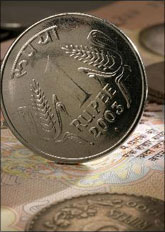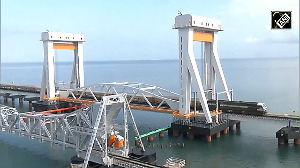 The government is under pressure to begin fiscal consolidation with the Budget as India's fiscal deficit has gathered dangerous proportions on the back of the stimulus measures taken to revive the economy and due to rising government expenditure.
The government is under pressure to begin fiscal consolidation with the Budget as India's fiscal deficit has gathered dangerous proportions on the back of the stimulus measures taken to revive the economy and due to rising government expenditure.
Sources say that the Budget is not likely to peg fiscal deficit below the 5.5 per cent-mark -- as was earlier estimated -- because the government is very eager to accelerate expenditure in the agriculture and social sectors.
Finance Minister Pranab Mukherjee might aim for a fiscal deficit of 6.1 per cent of the GDP for the year 2010-11, although he has been stressing on the need to keep fiscal deficit at 5.5 per cent of the GDP in 2010-11 and 4.0 per cent in 2011-12. The current year's fiscal deficit is estimated to be at 6.8 per cent levels.
The finance minister faces a major challenge when he tries to balance the need to curb rising fiscal deficit against the need to finance the country's social sectors without impeding growth.
The government's estimate of the fiscal deficit will be known when the finance minister presents the Union Budget for 2010-11 on February 26.
The finance minister is also caught in a bind over whether the fiscal stimuli provided to the industry to help it tide over the problem of an economic slowdown should be rolled back in a phased manner. If the stimulus measures are withdrawn too quickly, sectors that have just begun to come out of the slowdown might slip back in to a recession, but if the rollback in not done in time, fiscal deficit could rise rapidly constricting the government's ability to spend more on major sectors.
But even though the finance minister has held that India cannot sustain high fiscal deficit in the long run, he might not be able to roll back the duty sops given to the industry to insulate it from the ill-effects of the global economic crisis.
If these sops are continued during the fiscal year 2010-11 too, it would amount to a 'loss' of around Rs 60,000 crore (Rs 600 billion) to the exchequer, but pre-Budget industry wish-lists to the finance minister have been lobbying for the continuance of the stimulus.
With most world economies still to come out of the recessionary quagmire they found themselves in during the last year and the domestic demand too not yet robust enough, the industry might be justified in pleading for an extension of the sops given during late 2008 and early 2009.
Some finance ministry mandarins believe that tax benefits announced in the stimulus package should be partially rolled back, while excise duties and service tax should be raised by 2 per cent; but economists and industry bodies believe that the government should not tinker with this just yet.
The industry feels that withdrawing the stimulus could hurt the nation's growth and the government's prime aim must be to push forward for 8 per cent-plus growth as it will lead to higher tax collections and add to the revenue kitty. This will also help reduce the fiscal deficit to that extent, they argue.
And even as the Reserve Bank of India recently hinted at a tightening of the monetary stimulus, C Rangarajan, chairman of the Prime Minister's Economic Advisory Council, said that any unwinding of the fiscal stimulus should be gradual.
Rangarajan said that the unwinding of the stimulus measures should be done gradually so that the step is non-disruptive to the real economy.
Another hint that the government may delay rolling back the stimulus measures also came from India's chief statistician Pronab Sen.
However, Sen said that if Finance Minister Pranab Mukherjee 'plays a gamble' and relies on strong industrial growth numbers, it may well think of withdrawing some of the stimulus measures in the forthcoming Budget.
'It is up to the finance minister to either play safe (in the Budget) and wait for actual economic figures to come out or play gamble and take a decision depending on industrial growth numbers,' Sen said recently in New Delhi.
Economic growth numbers for the current fiscal are expected to be out by May-end and would provide true picture of whether demand has started picking up or not.
While industrial growth numbers have been strong in recent months, they only give supply side figures and does not indicate demand in the system, Sen said and pointed out that strong industrial growth numbers may be adding to inventories and actually may not be totally consumed.







 © 2025
© 2025